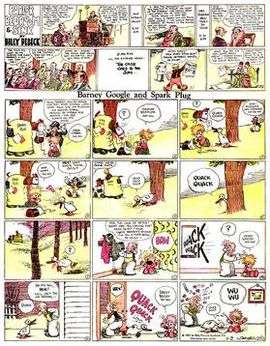Sunday strip

A Sunday strip is a newspaper comic strip format, where comic strips are printed in the Sunday newspaper, usually in a special section called the Sunday comics, and virtually always in color. Some readers called these sections the Sunday funnies. Some newspapers, such as Grit, published Sunday strips in black-and-white, and some (mostly in Canada) print their Sunday strips on Saturday.
Subject matter and genres have ranged from adventure, detective and humor strips to dramatic strips with soap opera situations, such as Mary Worth. A continuity strip employs a narrative in an ongoing storyline. Other strips offer a gag complete in a single episode, such as Little Iodine and Mutt and Jeff.
The Sunday strip is contrasted with the daily comic strip, published Monday through Saturday, usually in black and white. Many comic strips appear both daily and Sunday, in some cases, as with Little Orphan Annie, telling the same story daily and Sunday, in other cases, as with The Phantom, telling one story in the daily and a different story in the Sunday. Some strips, such as Prince Valiant appear only on Sunday. Others, such as Rip Kirby, are daily only and have never appeared on Sunday.
In some cases, such as Buz Sawyer, the Sunday strip is a spin-off, focusing on different characters than the daily.
Format
Early strips
Early Sunday strips usually filled a full newspaper page, but over decades they shrank in size, becoming smaller and smaller. Currently, no Sunday strips stand alone on a page, and some newspapers crowd as many as eight Sunday strips on a single page. The last full-page Sunday strip was Prince Valiant, which was published as a full page in some newspapers until 1970. Shortly after the full-page Prince Valiant was discontinued, Hal Foster retired from drawing the strip, though he continued to write it for several more years. Manuscript Press published a print of his last Prince Valiant strip in full-page format; this was the last full-page comic strip, though it did not appear in that format in newspapers.[1]
Other formats
Other formats for Sunday strips include the half-page, the third of a page, the quarter page, the tabloid page or tab, and the half tab, short for half of a tabloid page. Today, with the ever-shrinking size of Sunday strips, many other smaller formats abound.[1]
Usually, only the largest format is complete, with the other formats dropping or cropping one or more panels. Such "throwaway" panels often contain material that is not vital to the main part of the strip. Most cartoonists fill the first two panels of their strips with a "throwaway gag," knowing that the public may not see them, and making them integral to the plot would likely be wasteful. Exceptions to this rule include Steve Canyon and, until its last few years, On Stage, which are complete only in the third format. Half-page Sunday strips have at least two different styles. The King Features, the Creators' and the Chicago Tribune syndicates use nine panels (with only one used for the title), while United Features and Universal Press' half-page Sunday strips (most of them use a third-page format instead) use two panels for the title (except for Jim Davis' U.S. Acres -which used the nine-panel format- during the 1980s, when most UFS strips -particularly Davis' more successful Garfield- would have a throwaway gag).
Currently, the largest and most complete format for most Sunday strips, such as Peanuts, is the half page. A few strips have been popular enough for the artist to insist on the Sunday strip being run in a half-page format, though not necessarily in a half-page size. Calvin and Hobbes was the first strip to do this, followed by Outland and later Opus. The Reading Eagle is one of the few newspapers that still run half-page Sunday strips.[1]
In some cases today, the daily strip and Sunday strip dimensions are almost the same. For instance, a daily strip in The Arizona Republic measures 4 3⁄4" wide by 1 1⁄2" deep, while the three-tiered Hägar the Horrible Sunday strip in the same paper is 5" wide by 3 3⁄8" deep.
Popular strips

Famous full-page Sunday strips include Alley Oop, Barney Google and Snuffy Smith, Blondie, Bringing Up Father, Buck Rogers, Captain Easy, Flash Gordon, and Thimble Theatre. Such classics have found a new home in book collections of recent years. On the other hand, numerous strips such as Bob Gustafson's Specs and Virgil Partch's The Captain's Gig are almost completely forgotten today, other than a brief display in the Stripper's Guide site run by comics historian Allan Holtz.
Many of the leading cartoonists also drew an accompanying topper strip to run above or below their main strip, a practice which began to fade away during the late 1930s. Holtz notes, "You'll hear historians say that the topper strip was a victim of World War II paper shortages. Don't believe a word of it—it's the ads that killed full-page strips, and that killed the topper. World War II only exacerbated an already bad situation."[2]
Revivals
During the 1950s, there were a few short-lived attempts to revive the full-page Sunday strip. Examples such as Lance by Warren Tufts and Frank Giacoia's Johnny Reb and Billy Yank proved artistic, though not commercial, successes.
See also
References
Further reading
- Robinson, Jerry, The Comics: An Illustrated History of Comic Strip Art (1974) G.P. Putnam's Sons
- Horn, Maurice, The World Encyclopedia of Comics (1976) Chelsea House, (1982) Avon
- Blackbeard, Bill, ed. The Smithsonian Collection of Newspaper Comics (1977) Smithsonian Inst. Press/Harry Abrams
